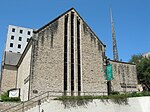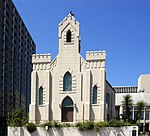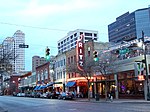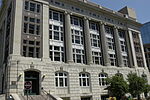J.J. Pickle Federal Building

The J.J. Pickle Federal Building is one of the largest mid-century modern buildings in Texas and has a rich political history. The eleven-story structure is a quintessential specimen of mid-century high-rises with its vertically oriented, uniform exterior grid that "reflects a golden age for civic architecture in the 1950s and 1960s". The building is known for its famous occupants, including Congressman J. J. Pickle and President Lyndon B. Johnson. The building occupies the entire block on 8th street between San Jacinto Boulevard and Trinity Street in downtown Austin, Texas. There is an outdoor plaza on the north half of the site that connects to the first floor. The ground floor is at street level on 8th street.
Excerpt from the Wikipedia article J.J. Pickle Federal Building (License: CC BY-SA 3.0, Authors, Images).J.J. Pickle Federal Building
East 8th Street, Austin
Geographical coordinates (GPS) Address Nearby Places Show on map
Geographical coordinates (GPS)
| Latitude | Longitude |
|---|---|
| N 30.2694 ° | E -97.7391 ° |
Address
J.J. Pickle Federal Building
East 8th Street
78767 Austin
Texas, United States
Open on Google Maps









